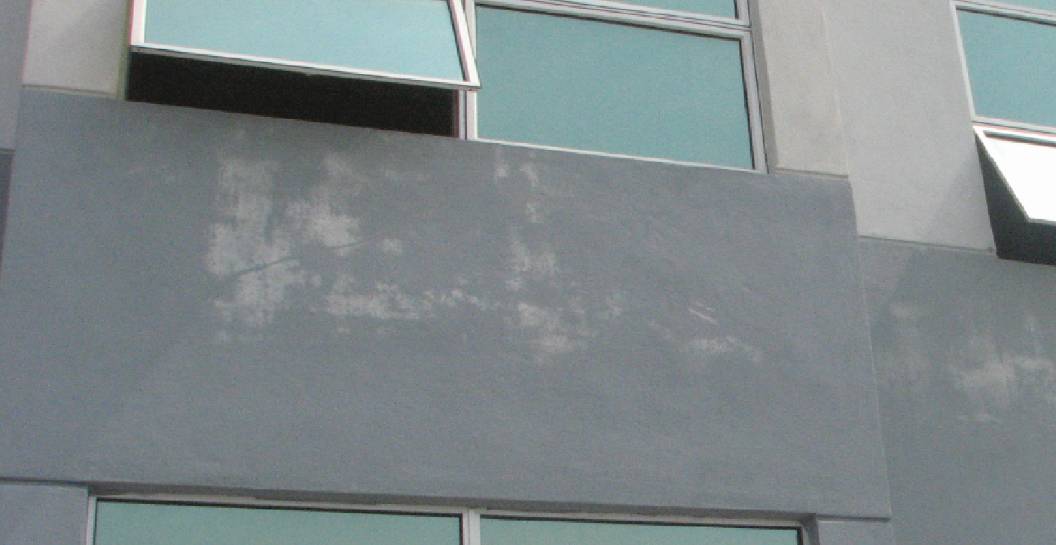Features of problem
The colour has faded. It is a blotchy, uneven stain. When using your hand to rub, it may look like dust on your hand. It usually occurs with exterior paint that is exposed to weather conditions such as sunlight, where light will gradually destroy the paint film to deteriorate and fade. It may occur with new plaster walls that has accelerated work.
Cause
The colour fading problem can be found both inside and outside but it is often found with exterior paint due to the harsh weather conditions. There are several reasons for the occurrence as follows:
Over time, the exterior paint will be destroyed by sunlight. The reaction between colour and sunlight deteriorates the colour to change from the original. Whether it is an old cement wall or a new cement wall, after delivering the work for about 4-5 months, you can see the fading as well.
It can be caused by painting the cement surface with high humidity. There is water seeping into the wall after painting. The water will dissolve the alkali in the cement. Alkali will react with the paint film causing the glue to deteriorate and cause the colour to fade quickly.
It can be caused by not painting the primer or using the wrong type of paint, such as bringing paint for interior to paint outside which indoor paint is not resistant to weather conditions. In addition, it may be caused by the colour shades that are not resistant to UV rays, weather conditions, wind, rain, causing the shades to fade prematurely. Especially in areas exposed to sunlight, it causes the colour to deteriorate (most often they are dark shades such as bright red, bright yellow, blue).
How to solve
If the colour fading is caused by the deterioration of the paint film to chalk dust, the chalk dust must be removed first. Use a plastic brush to clean or use Water Jet to spray the wall to be free of dirt, grease and other foreign matters and allow the wall to dry completely.
The surface must not have cracks. If any, cracks must be repaired with quality material prior to coating. Where cracks are less than 2 mm in size, cracks are repaired with Nippon Paint Vinilex Wall Putty. For cracks larger than 2 mm, fill with Terracryl.
For the areas with moss and fungi, scrub with Nippon Paint Vinilex Biowash fungicide and apply Nippon Paint Vinilex Biowash fungicide. Leave it overnight. The surface before painting must be clean and completely dry. If following Nippon Paint standards, the moisture content must not be more than 6% by Kett model HI-520 or not more than 14% by Protimeter Mini and not more than pH 8.
Apply 1 coat of old plaster primer (recommended paint system for exterior: 1 coat of Old Cement Primer, Nippon Paint Excel Primer, recommended paint system for interior: 1 coat of Nippon Paint Water-Based Primer Aqua Sealer) and 2 coats of Topcoat (Recommended colour system for exterior: 2 coats of Nippon Paint Weatherbond, recommended paint system for interior: 2 coats of Nippon Paint Aircare).
How to prevent
Paint work according to the correct steps must pay attention to the surface preparation process. The surface before painting must be clean free from dust, dirt, grease and other foreign matter and completely dry without cracks to prevent water and moisture from seeping into the wall and the cement wall should be allowed to fully curing.
High quality paint should be chosen as it is more resistant to weather conditions. The colour formula is designed to be more resistant to sunlight and fading. Use it as recommended by the manufacturer.
Water-based primer: 1 coat of Nippon Paint 5100 Wall Sealer.
Oil-based primer for high humidity surfaces: 1-2 coats of Nippon Paint Tylelac Trans Sealer.
Topcoat for exterior: 2 coats of Nippon Paint Weatherbond.
Topcoat for interior: 2 coats of Nippon Paint Air Care.




















